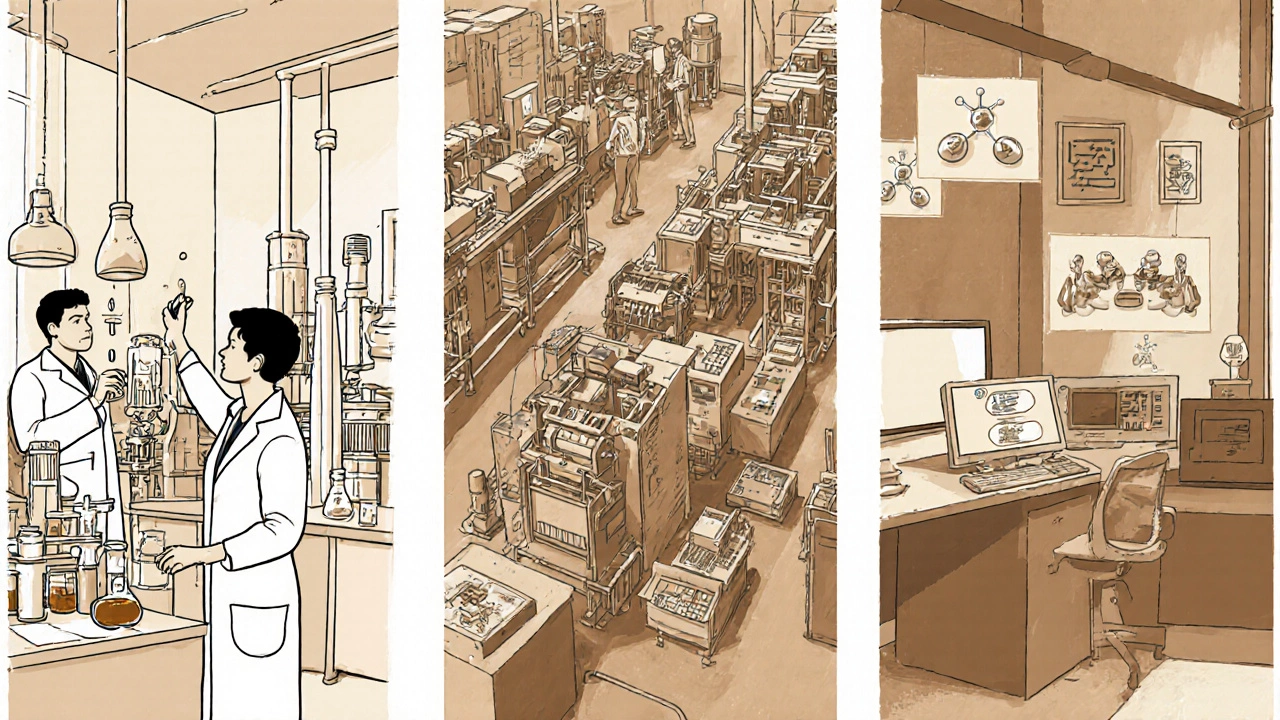How many pharma manufacturing companies are there in India?

Pharma Manufacturing Company Calculator
Pharma Company Distribution Calculator
Explore how India's pharmaceutical manufacturing companies are distributed by category and state.
Select a category and state to see the distribution
Key Takeaways
- As of October 2025, India hosts roughly 12,400 registered pharmaceutical manufacturing companies.
- More than 55% of them are concentrated in Maharashtra, Gujarat and Karnataka.
- There are three main categories: API (active‑ingredient) producers, formulation manufacturers, and contract research organisations (CROs).
- Official data comes from the Central Drugs Standard Control Organization (CDSCO), Ministry of Commerce, and industry bodies like the Indian Drug Manufacturers’ Association (IDMA).
- Numbers are updated annually; you can verify them through the CDSCO online registry or state‑wise pharma directories.
What "pharmaceutical manufacturing companies in India" really means
Pharmaceutical manufacturing companies in India are businesses that are licensed by the Central Drugs Standard Control Organization (CDSCO) to produce either active pharmaceutical ingredients (APIs), finished dosage forms, or both, for domestic consumption or export. The sector spans from small‑scale generic producers to large multinational R&D hubs.
Why the exact count matters
Investors, policy‑makers, and supply‑chain partners all need a reliable head‑count to gauge market size, assess competition, and plan capacity expansions. A clear figure also helps the government track compliance with the "Make in India" pharma push.
Where the data comes from
Three sources dominate the official landscape:
- CDSCO’s Drug Licensing Database - publishes a searchable list of all active licences.
- Ministry of Commerce’s Export‑Import Statistics - cross‑checks producers registered for export.
- Industry associations such as IDMA and the Organisation of Pharma Producers of India (OPPI) - release annual membership counts.
All three were cross‑referenced in the latest 2025 audit, which eliminated duplicate entries and removed firms that ceased operations in 2024.

Current head‑count (2025)
The consolidated figure stands at about 12,400 active pharma manufacturers. Here’s the breakdown:
| Category | Number of firms | Share of total |
|---|---|---|
| API manufacturers | 4,800 | 38.7% |
| Formulation manufacturers | 6,200 | 50.0% |
| Contract Research/Manufacturing Organisations (CRO/CMOs) | 1,400 | 11.3% |
State‑wise concentration
Geography plays a big role. Maharashtra, Gujarat and Karnataka together account for more than half of all manufacturers.
| State | Companies | Percentage |
|---|---|---|
| Maharashtra | 3,200 | 25.8% |
| Gujarat | 2,900 | 23.4% |
| Karnataka | 2,300 | 18.5% |
| Tamil Nadu | 1,200 | 9.7% |
| Andhra Pradesh | 1,100 | 8.9% |
These hubs benefit from established logistics, skilled labor pools, and proximity to major ports for export.
Types of manufacturers - what you need to know
Understanding the three main groups helps you interpret the head‑count correctly:
- API manufacturers - Produce the chemical building blocks. India is the world’s largest API exporter, accounting for roughly 30% of global supply.
- Formulation manufacturers - Turn APIs into tablets, capsules, injectables, etc. This segment includes both generic and branded drug producers.
- CRO/CMOs - Offer research, development, and small‑batch manufacturing services to global pharma firms. Their numbers are growing fast due to rising outsourcing trends.

How to verify the numbers yourself
If you need the most up‑to‑date count, follow these steps:
- Visit the CDSCO Drug Licensing portal and download the latest "Licensed Manufacturers" CSV.
- Filter by "Active" status and remove entries marked "Revoked" or "Expired".
- Cross‑check the list with the IDMA membership directory (available on request to members).
- For export‑focused firms, use the Ministry of Commerce’s "Exporters and Importers Database" and apply the keyword filter "pharmaceutical".
- Combine the three datasets in a spreadsheet, de‑duplicate by company registration number, and you’ll arrive at the current count.
Most analysts repeat this process annually; the 2025 figure reflects the July‑December 2024 reporting window.
Trends shaping the landscape
Three forces are likely to change the head‑count in the next few years:
- Regulatory tightening - New GMP rules introduced in 2024 have forced several small units to shut down or merge.
- Consolidation - Big players like Sun Pharma and Cipla are acquiring niche API firms, reducing the total number but boosting capacity.
- Biologics entry - The biotech segment is still counted under "pharma" but will spawn a new class of manufacturers, potentially adding 800‑1,000 specialised firms by 2028.
Keeping an eye on these trends will help you anticipate shifts in the total count.
Quick checklist for stakeholders
- Use the CDSCO licence database as the primary source.
- Validate with at least one industry association.
- Track state‑wise changes quarterly if you operate in hub regions.
- Adjust forecasts for regulatory and consolidation impacts.
How often does the CDSCO update its manufacturer list?
The CDSCO refreshes the licence database quarterly, with a comprehensive annual audit that removes inactive or revoked licences.
Are private biotech firms counted in the pharma manufacturer total?
Only if they hold a CDSCO manufacturing licence for drugs or biologics. Pure research‑only biotech start‑ups are excluded.
Which state has the fastest growth rate for new manufacturers?
Karnataka has seen a 12% year‑on‑year increase, driven by government incentives for biotech clusters in Bengaluru.
Can foreign companies be included in the count?
Yes, as long as they operate a manufacturing unit in India with a valid CDSCD licence. Many MNCs run joint‑venture plants.
Where can I download the latest export‑oriented pharma list?
The Ministry of Commerce’s "Exporters and Importers Database" provides a filter for "pharmaceutical manufacturing" and can be exported as CSV.





